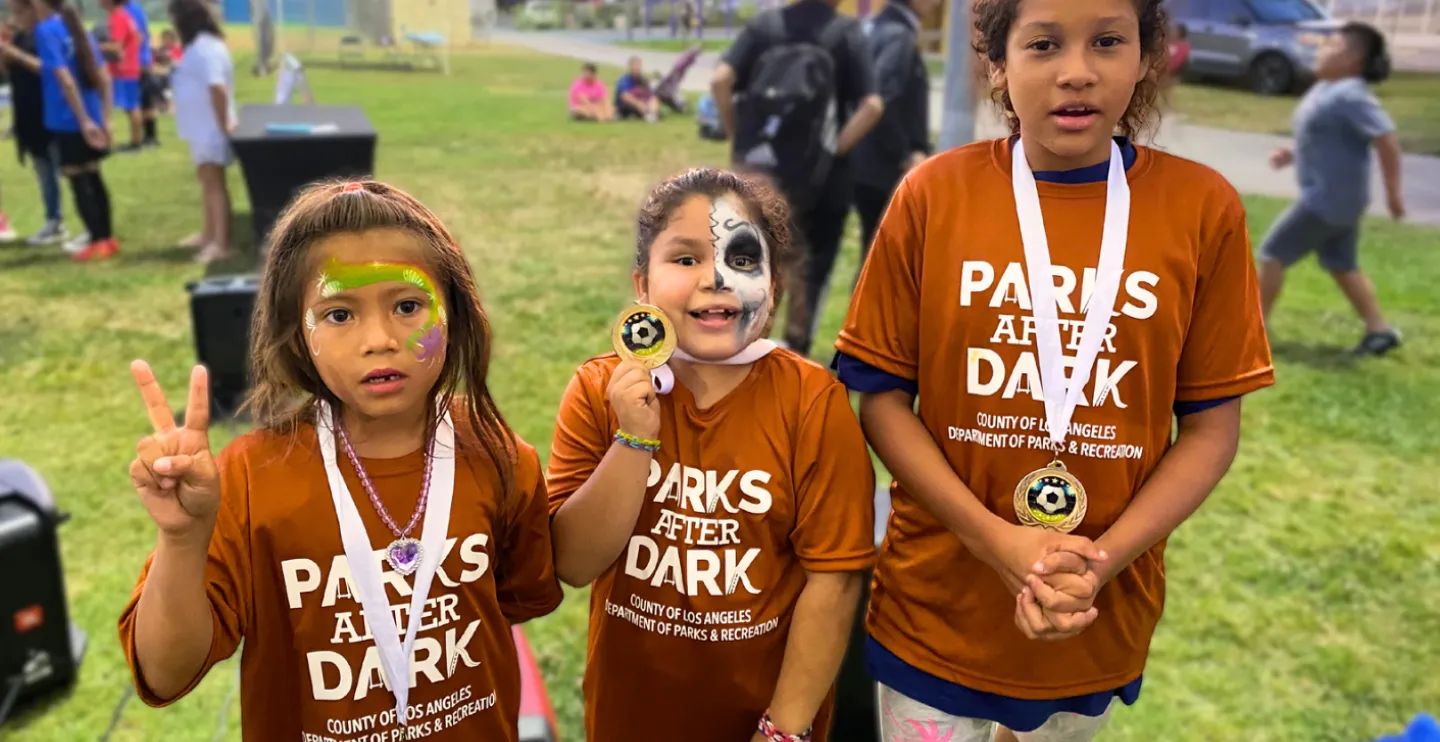A survey of attendees in 2023 found that 93% felt safe at Parks After Dark.
Parks After Dark, the free Los Angeles County program that provides a safe space for people primarily during evening hours, fosters stronger feelings of community and closer connections among neighbors, according to a report from the UCLA Center for Health Policy Research.
Ninety-six percent of people surveyed said that Parks After Dark provides a sense of belonging within their communities, and 94% said the program helped them get to know their neighbors better.
“Research shows that parks and public green spaces are crucial for health because they provide places for outdoor recreation and exercise,” said Nadereh Pourat, director of the UCLA Center for Health Policy Research’s Health Economics and Evaluation Research Program, and the report’s lead author. “Parks After Dark is designed to increase safety of parks and provide programs that everyone can enjoy.”
Overall, the program had more than 405,000 unique visits throughout its eight-week run in summer 2023. The most popular activities were movie nights, concerts, and sports clinics and games.
“I love what you guys do for the community and accept everybody individually and equally,” said one person who attended Parks After Dark activities at George Washington Carver Park, which is about 10 miles south of downtown Los Angeles. “It is good that everyone has a good time together as a family.”
The Los Angeles County Department of Parks and Recreation launched Parks After Dark in 2010 in neighborhoods that had higher-than-average rates of crime, poverty and obesity. The program has grown from three parks when it began to 34 in 2023. It expanded in 2022 to include one-day events around spring and winter school breaks.
Since 2010, there has been an estimated reduction of 74 serious and violent crimes, such as robbery, and 43 nonviolent crimes, like vandalism, in participating parks and their surrounding communities.
Of the participants surveyed in 2023, 93% said they felt safe attending Parks After Dark, and among attendees who expressed not feeling safe in their neighborhood overall, 64% said they felt safe at Parks After Dark.
The feelings of safety came from a range of factors, including the presence of L.A. County sheriff’s deputies, friendly park staff, good lighting — and in the South Region, the presence of community-based intervention workers. The report credits the program for complementing the presence of deputies with intervention workers in communities where uncomfortable relationships exist between some residents and law enforcement.
The report highlights how “intervention workers often have a deep understanding of community dynamics and events and work collaboratively with Parks After Dark staff to anticipate any potential safety concerns,” as noted by Parks After Dark partners.
Parks After Dark had positive health impacts. Among attendees who did not meet the recommended activity guidelines for their age, 72% participated in physical activity. Maintaining their level of physical activity year-round would primarily reduce stroke and ischemic heart disease — and lead to an overall decline of 20 fewer years of disability-adjusted life years. This reduction in disease burden is associated with an estimated $2.974 million in savings in 2023.
“Our study highlights the importance of public investments in parks to improve health, particularly in areas of Los Angeles County with above-average crime rates and among populations with limited resources and at higher risk of chronic diseases,” Pourat said.
Parks After Dark leaders added goals in 2023 to expand youth development opportunities and engage more older adults.
“Now in its 14th season, the L.A. County Parks After Dark initiative is elevating our commitment to programming based on feedback from our attendees. This summer, we’re thrilled to introduce an exciting lineup of events, including an eight-week concert and movie series, sports leagues for all ages, senior social hours, teen zones and an incredible lineup of aquatic experiences for the whole family,” said Norma Edith García-González, director of Los Angeles County Parks and Recreation. “Our commitment to park safety, physical and mental well-being, and youth work experience remains a top priority for Parks After Dark.”
The Youth at Work program offered individuals 14–24 years old paid work experience and training in professional skills, like customer service, along with opportunities for long-term employment with the Department of Parks and Recreation. From July 2022 to June 2023, more than 370 youth worker placements occurred across the 34 participating parks.
Parks After Dark showed success engaging older adults in parks that had established senior centers, activities and programming, such as senior dances, in addition to the L.A. County initiative.
The report made specific recommendations based on 2023 Parks After Dark evaluation data and findings. They include:
- Promote safety at Parks After Dark parks through a combination of sheriff’s deputies and expanded involvement of community-based intervention workers.
- Increase physical activity offerings to appeal to a variety of age groups and interests to maximize the impact on chronic disease.
- Ensure staffing support for Parks After Dark by planning in advance and exploring opportunities for youth employment and community volunteers.
- Continue tailoring programs to meet the needs and desires of the people living near each participating park.
Featured Publications
The UCLA Center for Health Policy Research (CHPR) is one of the nation’s leading health policy research centers and the premier source of health policy information for California. UCLA CHPR improves the public’s health through high quality, objective, and evidence-based research and data that informs effective policymaking. UCLA CHPR is the home of the California Health Interview Survey (CHIS) and is part of the UCLA Fielding School of Public Health.




